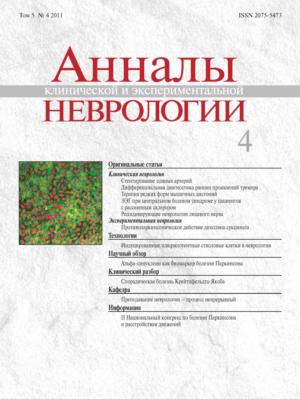Альфа-синуклеин как биомаркер болезни Паркинсона
- Авторы: Пчелина С.Н.1
-
Учреждения:
- Санкт-Петербургский государственный медицинский университет им. акад. И.П. Павлова
- Выпуск: Том 5, № 4 (2011)
- Страницы: 46-51
- Раздел: Обзоры
- Дата подачи: 03.02.2017
- Дата публикации: 13.02.2017
- URL: https://annaly-nevrologii.com/journal/pathID/article/view/289
- DOI: https://doi.org/10.17816/psaic289
- ID: 289
Цитировать
Полный текст
Аннотация
В качестве основного звена патогенеза болезни Паркинсона (БП) рассматривается формирование нейротоксических агрегатов небольшого пресинаптического белка альфа-синуклеина. Сегодня не существует диагностических тестов БП, основанных на биохимических исследованиях доступных биологических жидкостей (кровь, цереброспинальная жидкость). Поиск биомаркеров, позволяющих проводить диагностику и мониторинг заболевания, остается крайне актуальным. В ряде исследований предложено использование уровня периферического альфа-синуклеина в качестве прогностического маркера БП, однако до настоящего момента этот вопрос остается открытым. Работы по сопоставлению уровня мономерного альфа-синуклеина лимфоцитов периферической крови, плазмы и цереброспинальной жидкости у пациентов с БП и в контроле носят противоречивый характер. Разработка методов выявления и количественной оценки олигомерных форм альфа-синуклеина в сочетании с развитием методов нейровизуализации может рассматриваться как наиболее перспективное направление.
Ключевые слова
Об авторах
С. Н. Пчелина
Санкт-Петербургский государственный медицинский университет им. акад. И.П. Павлова
Автор, ответственный за переписку.
Email: sopchelina@hotmail.com
Россия, Санкт-Петербург
Список литературы
- Иллариошкин С.Н. Конформационные болезни мозга. М.: Янус-К, 2003.
- Иллариошкин С.Н., Иванова-Смоленская И.А., Маркова Е.Д. ДНК-диагностика и медико-генетическое консультирование в неврологии. М.: МИА, 2002.
- Литвиненко И.В., Одинак М.М., Сологуб О.С. и др. Гипергомоцистеинемия при болезни Паркинсона – новый вариант осложнений проводимой терапии или специфический биохимический маркер заболевания? Анн. клин. эксп. неврол. 2008; 2: 13–17.
- Пчелина С.Н., Емельянов А.К., Якимовский А.Ф. и др. Сниженный уровень альфа-синуклеина в лейкоцитах периферической крови у пациентов с LRRK2-ассоциированной болезнью Паркинсона. Бюл. эксп. биол. мед. 2010; 12: 619–621.
- Пчелина С.Н., Иванова О.Н., Емельянов А.К. и др. Мутации в гене LRRK2 у больных с болезнью Паркинсона в России. Мед. ген. 2006; 5: 48–51.
- Пчелина С.Н., Якимовский А.Ф., Шварц Е.И. Наследственные основы болезни Паркинсона. Мед. ген. 2003; 9: 411–425.
- Скоромец А.А., Скоромец А.П., Скоромец Т.А. Нервные болезни. М.: МЕДпресс-информ, 2005.
- Угрюмов М.В. (ред.) Нейродегенеративные заболевания. Фундаментальные и прикладные аспекты. М.: Наука, 2010.
- Aerts M.B., Esselink R.A., Abdo W.F. et al. CSF α-synuclein does not differentiate between parkinsonian disorders. Neurobiol. Aging 2011 (e-pub ahead of print).
- Anderson J., Walker D.E., Goldstein J.M. et al. Phosphorylation of Ser-129 is the dominant pathological modification of alpha-synuclein in familial and sporadic Lewy body disease. J. Biol. Chem. 2006; 281: 29739–29752.
- Barbour R., Kling K., Anderson J.P. et al. Red blood cells are the major source of alpha-synuclein in blood. Neurodegen. Dis. 2008; 5: 55-59.
- Bisaglia M., Greggio E., Dragan M. et al. α-Synuclein overexpression increases dopamine toxicity in BE(2)-M17. Cells BMC Neuroscience 2010; 11: 41.
- Bisaglia M., Mammi S., Bubacco L. Structural insights on physiological functions and pathological effects of alpha-synuclein. FASEB J. 2009; 23: 329–340.
- Brighina L., Prigione A., Begni B. et al. Lymphomonocyte alphasynuclein levels in aging and in Parkinson disease. Neurobiol. Aging 2010; 31: 884–885.
- Cabin D.E., Shimazu K., Murphy D. et al. Synaptic vesicle depletion correlates with attenuated synaptic responses to prolonged repetitive stimulation in mice lacking alpha-synuclein. J. Neurosci. 2002; 22: 8797–8807.
- Carballo-Carbajal I., Weber-Endress S., Rovelli G. et al. Leucinerich repeat kinase 2 induces alpha-synuclein expression via the extracellular signal-regulated kinase pathway. Cell Signal. 2010; 22: 821–827.
- Carotini B., Tanda G., Colosimo C. Reduced dopamine in peripheral blood lymphocytes in Parkinson’s disease. NeuroReport 1999; 10: 2907–2920.
- Conway K.A., Harper J.D., Lansbury P.T. Accelerated in vitro fibril formation by a mutant alpha-synuclein linked to early-onset Parkinson disease. Nat. Med. 1998; 4: 1318–1320.
- Cookson M.R., van der Brug M. Cell systems and the toxic mechanism( s) of alpha-synuclein. Exp Neurol. 2008; 209: 5–11.
- Davidson W.S., Jonas A.., Clayton D.F., George J.M. Stabilization of alpha-synuclein secondary structure upon binding to synthetic membranes. J. Biol. Chem. 1998; 273: 9443–9449.
- El-Agnaf O.M., Salem S.A., Paleologou K.E. et al. Detection of oligomeric forms of alpha-synuclein protein in human plasma as a potential biomarker for Parkinson’s disease. FASEB J. 2006; 20: 419–425.
- Feany M.B., Bender W.W. A drosophila model of Parkinson’s disease. Nature 2000; 404: 394–398.
- Fuchs J., Tichopad A., Golub Y. et al. Genetic variability in the SNCA gene influences alpha-synuclein levels in the blood and brain. FASEB J. 2008; 22: 1327–1334.
- Giasson B.I., Murray I.V., Trojanowski J.Q., Lee V.M. A hydrophobic stretch of 12 amino acid residues in the middle of alpha-synuclein is essential for filament assembly. J. Biol. Chem. 2001; 276: 2380–2386.
- Greggio E., Bisaglia M., Civiero L., Bubacco L. Leucine-rich repeat kinase 2 and alpha-synuclein: intersecting pathways in the pathogenesis of Parkinson’s disease? Mol. Neurodegen. 2011; 6: 6.
- Greten-Harrison B., Polydoro M., Morimoto-Tomita M. et al. αβγ- Synuclein triple knockout mice reveal age-dependent neuronal dysfunction. PNAS 2010; 107: 19573–19578.
- Hong Z., Shi M., Chung K.A. et al. DJ-1 and alpha-synuclein in human cerebrospinal fluid as biomarkers of Parkinson’s disease. Brain 2010; 133: 713–726.
- Ibáñez P., Lesage S., Janin S. et al. Alpha-synuclein gene rearrangements in dominantly inherited parkinsonism: frequency, phenotype, and mechanisms. Arch. Neurol. 2009; 66: 102–108.
- Kikuchi A., Takeda A., Okamura N. et al. In vivo visualization of alpha-synuclein deposition by carbon-11-labelled 2-[2-(2-dimethylaminothiazol- 5-yl)ethenyl]-6-[2-(fluoro)ethoxy]benzoxazole positron emission tomography in multiple system atrophy. Brain 2010; 133: 1772–1778.
- Kim S., Seo J.H., Suh Y.H. Alha-synuclein, Parkinson’s disease, and Alzheimer’s disease. Parkinsonism. Relat. Disord. 2004; 10: S9–13.
- Kruger R., Kuhn W., Muller T. et al. Ala30Pro mutation in the gene encoding alphasynuclein in Parkinson’s disease. Nat. Genet. 1998; 18: 106–108
- Lee F.J.S., Liu F., Pristupa Z.B., Niznik H.B. Direct binding and functional coupling of alpha-synuclein to the dopamine transporters accelerate dopamine-induced apoptosis. Faseb J. 2001; 15: 916–926.
- Lee P.H., Lee G., Park H.J. et al. The plasma alpha-synuclein levels in patients with Parkinson’s disease and multiple system atrophy. J. Neural Transm. 2006; 13: 1435–1439.
- Li Q.X., Mok S.S., Laughton K.M. et al. Plasma alpha-synuclein is decreased in subjects with Parkinson’s disease. Exp. Neurol. 2007; 204: 583–588.
- Luk K.C., Song C., O’Brien P. et al. Exogenous alpha-synuclein fibrils seed the formation of Lewy body-like intracellular inclusions in cultured cells. PNAS 2009; 106: 20051–20056.
- Maroteaux L., Campanelli J.T., Scheller R.H. Synuclein — a neuron- specific protein localized to the nucleus and presynaptic nerve-terminal. J. Neurosci. 1988; 8: 2804–2815.
- Masliah E., Rockenstein E., Veinbergs I. et al. Dopaminergic loss and inclusion body formation in alpha-synuclein mice: implications for neurodegenerative disorders. Science 2000; 287: 1265–1269.
- Michell A.W., Luheshi L.M., Barker R.A. Skin and platelet alphasynuclein as peripheral biomarkers of Parkinson’s disease. Neurosci. Lett. 2005; 381: 294–298.
- Miller D.W., Crawley A., Gwinn-Hardy K. et al. Unaltered alphasynuclein blood levels in juvenile Parkinsonism with a parkin exon 4 deletion. Neurosci. Lett. 2005; 374: 189–191.
- Miller D.W., Hague S.M., Clarimon J. et al. Alpha-synuclein in blood and brain from familial Parkinson disease with SNCA locus triplication. Neurology 2004; 62: 1835–1838.
- Mollenhauer B., Cullen V., Kahn I. et al. Direct quantification of CSF alpha-synuclein by ELISA and first cross-sectional study in patients with neurodegeneration. Exp. Neurol. 2008; 213: 315–325.
- Nemani V.M., Lu W., Berge V. et al. Increased expression of alphasynuclein reduces neurotransmitter release by inhibiting synaptic vesicle reclustering after endocytosis. Neuron 2010; 65: 66–79.
- Nishioka K., Hayashi S., Farrer M.J. et al. Clinical heterogeneity of alpha-synuclein gene duplication in Parkinson’s disease. Ann. Neurol. 2006; 59: 298–309.
- Pankratz N., Nichols W.C., Elsaesser V.E. et al. Alpha-synuclein and familial Parkinson’s disease. Mov. Disord. 2009; 24: 1123–1125.
- Pchelina S.N., Yakimovskii A.F., Emelyanov A.K. et al. Screening for LRRK2 mutations in patients with Parkinson’s disease in Russia: identification of a novel LRRK2 variant. Eur. J. Neurol. 2008; 15: 692–696.
- Pchelina S.N., Yakimovskii A.F., Ivanova O.N. et al. G2019S LRRK2 mutation in familial and sporadic Parkinson’s disease in Russia. Mov Disord. 2006; 21: 2234–2236.
- Pellicano C., Buttarelli F.R., Circella A. et al. Dopamine transporter immunoreactivity in peripheral blood lymphocytes discriminates Parkinson’s disease from essential tremor. J. Neural Transm. 2007; 114: 935–938.
- Perez R., Waymire J.C., Lin E. et al. A role for alpha-synuclein in the regulation of dopamine biosynthesis. J. Neurosci. 2002; 22: 3090–3099.
- Polwey E.D., Cherra S.J., Liu Y., Chu C.T. Role of autophagy in G2019S-LRRK2-associated neurite shortenibg in differentiated SHSY5Y cells. J. Neurocem. 2008; 105: 1048–1056.
- Polymeropoulos M.H., Lavedan C., Leroy E. et al. Mutation in the alpha-synuclein gene identifi ed in families with Parkinson’s disease. Science 1997; 276: 2045–2047.
- Prigione A., Piazza F., Brighina L. et al. Alpha-synuclein nitration and autophagy response are induced in peripheral blood cells from patients with Parkinson disease. Neurosci. Lett. 2010; 477: 6–10.
- Qing H., Wong W., McGeer E.G. et al. Lrrk2 phosphorylates alphasynuclein at serine 129: Parkinson disease implications. BBRC 2009; 387: 149–152.
- Satake W., Nakabayashi Y., Mizuta I. et al. Genome-wide association study identifies common variants at four loci as genetic risk factors for Parkinson’s disease. Nat. Genet. 2009; 41: 1303–1307.
- Shi M., Bradner J., Hancock A.M. et al. Cerebrospinal fluid biomarkers for Parkinson disease diagnosis and progression. Ann. Neurol. 2011; 69: 570–580.
- Simón-Sánchez J., Schulte C., Bras J.M. et al. Genome-wide association study reveals genetic risk underlying Parkinson’s disease. Nat. Genet. 2009; 41: 1308–1312.
- Singleton A.B., Farrer M., Johnson J. et al. alpha-Synuclein locus triplication causes Parkinson’s disease. Science 2003; 302(5646): 841.
- Spillantini M.G., Schmidt M.L., Lee V.M.Y. et al. Alph-asynuclein in Lewy bodies. Nature 1997; 388: 839–840.
- Tokuda T., Qureshi M.M., Ardah M.T. et al. Detection of elevated levels of α-synuclein oligomers in CSF from patients with Parkinson disease. Neurology 2010; 75: 1766–1772.
- Ueda K., Fukushima H., Masliah E. et al. Molecular cloning of cDNA encoding an unrecognized component of amyloid in Alzheimer disease. PNAS 1993; 90: 11282–11286.
- Vernon A.C., Ballard C., Modo M. Neuroimaging for Lewy body disease: is the in vivo molecular imaging of α-synuclein neuropathology required and feasible? Brain Res. Rev. 2010; 65: 28–55.
- Waxman E.A., Giasson B.I. A novel, high-efficiency cellular model of fibrillar alpha-synuclein inclusions and the examination of mutations that inhibit amyloid formation. J. Neurochem. 2010; 113: 374–88.
- Westerlund M., Belin A.C., Anvret A. et al. Cerebellar alpha-synuclein levels are decreased in Parkinson’s disease and do not correlate with SNCA polymorphisms associated with disease in a Swedish material. FASEB J. 2008; 22: 3509–3514.
- Zarranz J.J., Alegre J., Gomez-Esteban J.C. et al. The new mutation, E46K, of alpha- synuclein causes Parkinson and Lewy body dementia. Ann. Neurol. 2004; 55: 164–173.
Дополнительные файлы








